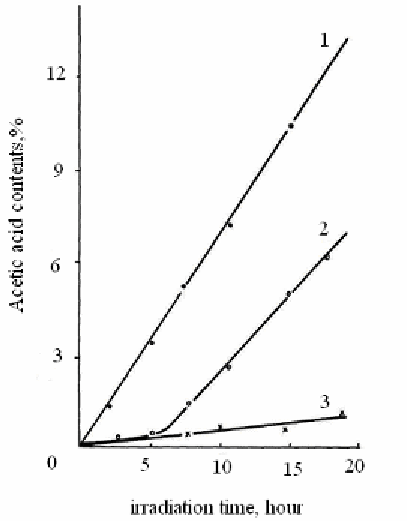Chemistry Reference
In-Depth Information
Figure 2.22. Change of the rate of acetic acid accumulation in the process of irradiation by carbon-arc
and mercury-quartz lamps. 1 - CA-film without additive; 2 - CA-film + 2% BA; 3 - CA-film + 2%
XXXV.
At natural insolation of CA-films kinetic dependences of acetic acid accumulation have
similar character. Acetic acid of nonstabilized cellulose acetate accumulates more quickly
than with BA and XXXV additives (Figure 2.23).
It should be noted that in all cases the largest inhibitive effect both according to viscosity
values and acetic acid accumulation, is shown by XXXIV and XXXV, whereas low-
molecular azomethine BA possesses slight light protective effect, which quickly decreases
with the increase of irradiation time.
Destruction of ester groups was observed on the change of infrared spectrum in the
ranges 1040 and 1230 cm
-1
. Comparison of kinetic of the change of absorption band intensity
at 1040 and 1230 cm
-1
in infrared spectra of irradiated and nonirradiated by ultra-violet light
CA-film in the air shows that as a result of ultra-violet light action complex destructive
processes take place in CDA, visual display of which is the decrease of absorption bands
intensity in the ranges 1040 and 1230 cm
-1
, corresponding to stretching vibrations of ester
bonds -C-O- (groups III) and change of carbonyl and aldehyde groups content. Curves run in
Figure 2.24 correlates with data of Figure 2.23, which shows uniform nature of CA
phototransformation at ultra-violet irradiation and dependences of stabilizing effect of
azomethine compound on its molecular weight.


Search WWH ::

Custom Search